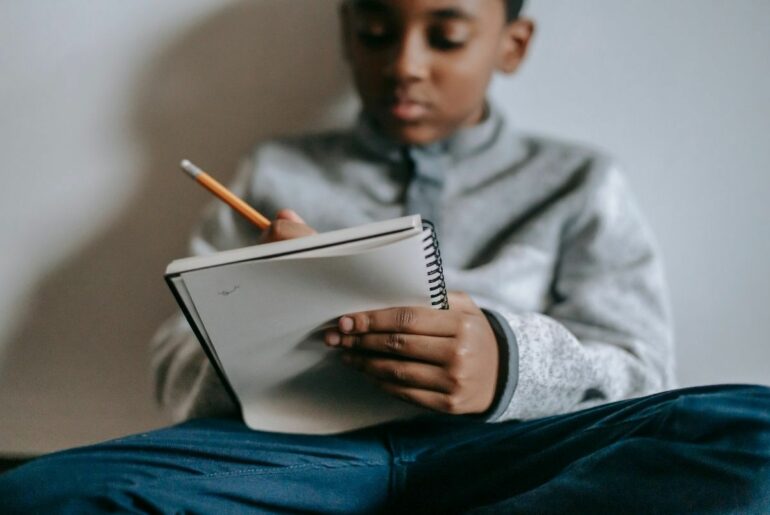What is “mindfulness” exactly? While the word may carry a lot of associations with certain spiritual or religious traditions that incorporate meditation or similar practices, it’s actually simply the act of paying attention. Shifting your focus to the present moment is a helpful way to reduce stress and improve overall mental health. Using a few age-appropriate activities, mindfulness can work for people of all ages!
As we move through our day, it’s common to let stress hijack our brains. By intentionally making time for mindfulness, your brain gets a break from worrying about the future and the past, and is able to slow down for a moment. Experts often refer to mindfulness as a “practice” because it works best when done on a frequent and ongoing basis, like you’d practice any other skill. This is a great reason to introduce the concept to kids—it’s much easier to build a healthy mindfulness habit when starting at an early age.
Mindfulness activities for toddlers and preschoolers
- Mindful movement—As parents of young kids know, getting them to sit still can be a challenge. Try using stretching, yoga, or dance as a mindfulness practice for this age group. Ask them to identify and move different parts of their body, or try to hold a position as long as they can while breathing in and out.
- Belly breathing—Have your kid lie on their back and place their hand on their belly. They can watch their hand move up and down as they breathe, which helps them focus on their breath and the present moment.
- Body scan—Have your child think about how they feel, preferably while they’re sitting or lying down comfortably. Ask them to focus on each part of their body, starting at their feet and working their way up to their head, and notice any sensations. Are their shoulders tense? Feet a little cold? Fingers tingly? Tummy feeling anxious? They don’t have to do anything about the sensations (scratch every itch, get a blanket if they’re chilly, etc) and it’s fine if they don’t feel anything in particular. The point is just to notice.
- Tactile play—Play with materials like clay, kinetic sand, or water. Ask your child what textures, temperatures, and other sensations they might feel as they play.
Mindfulness activities for big kids and preteens
- Grounding with the five senses—Grounding activities are used to interrupt stressful or racing thoughts and recenter the mind in the present moment. A simple, kid-friendly grounding activity is to take a moment to concentrate on each of the five senses—have your child focus on what they can see, hear, taste, smell, and feel right now.
- Thought bubbles—One of the goals of practicing mindfulness is to learn to accept whatever thoughts come up, and then let them go. It’s not possible to totally block out our thoughts and feelings, but by learning to let them pass without dwelling on them, we can reduce the amount of stress that comes from these thoughts. Have your child close their eyes and picture blowing bubbles, and then visualize putting each of their thoughts in a bubble and then watching them float away.
- A calm corner—Mindfulness is especially helpful when kids are feeling distressed or having a hard moment. Brainstorm with them some different coping strategies that help them calm down, and write each one on an index card. You might write things like “Write in my journal” or “Drink some water.” Then, you can decorate the cards together! Create a space in their room or a common room where they can keep these cards, and whatever else they need to self-soothe when they’re feeling upset, like favorite stuffed animals, pictures of loved ones, or art supplies.
Mindfulness activities for teens and parents
- Music or art therapy—If starting a regular mindfulness practice seems daunting, art and music can be an easy and intuitive way to get started. That Camila Cabello song your teen’s been listening to nonstop lately? Have them listen with their eyes closed and really tune into the different individual sounds that make up the song, and how it makes them feel. Do you often find yourself doodling while your mind wanders? Set an intention to draw for 5 or 10 minutes a day—and while you do, you can focus on how your body feels and what thoughts come up for you as you’re practicing.
- Slow, repetitive activities—Just about anything can be turned into a mindfulness practice if you do it mindfully! Think of which parts of your daily routine are quiet, slow, and repetitive. Washing your face, brushing your teeth, or doing the dishes are just a few examples. During these activities, focus on your breathing and the sensations you’re experiencing. If you start to let your mind wander, simply refocus on your breath. Adding this quiet moment into your routine is an easy way to keep stress levels down as you move through your busy day.
- Meditation apps—Meditation is one of the most effective mindfulness activities out there. Intentionally being still and focusing your attention for a sustained period of time can reduce your blood pressure, stress, and symptoms of anxiety and depression. There are a number of apps for people of all ages that make meditation easy. Aura, Simple Habit, and Calm are just a few examples of apps that provide guided meditations of all types, or timed self-guided or silent meditations depending on your preference. These apps usually allow you to set a reminder to meditate at a certain time each day, and save your favorite meditations to return to later.
The bottom line is that it’s easier than you might think to incorporate mindfulness into your family’s routine. It can also be a great excuse to check in and reconnect with your kids throughout the week. Practicing mindfulness on a regular basis is beneficial for kids and adults of all ages, and will have long-lasting positive impacts on your child’s stress levels and coping skills.







